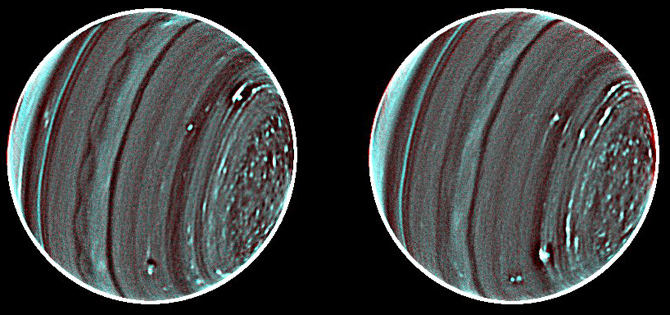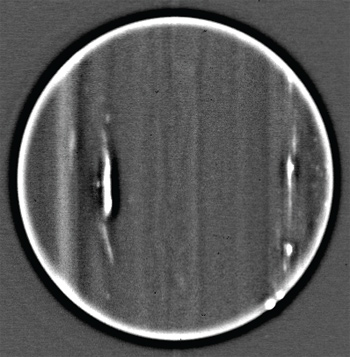Keck observations reveal complex face of Uranus

The planet Uranus, known since Voyager’s 1986 flyby as a bland, featureless blue-green orb, is beginning to show its face.
By using a new technique with the telescopes of the Keck Observatory, astronomers have created the most richly detailed, highest-resolution images ever taken of the giant ice planet in the near infrared, revealing an incredible array of atmospheric detail and more complex weather.
The planet, in fact, looks like many of the solar system’s other large planets — the gas giants Jupiter and Saturn, and the ice giant Neptune — said Imke de Pater, professor and chair of astronomy at the University of California, Berkeley, and one of the team members. The planet has bands of circulating clouds, massive swirling hurricanes and an unusual swarm of convective features at its north pole.
“This ‘popcorn’ appearance of Uranus’s pole reminds me very much of a Cassini image of Saturn’s south pole,” said de Pater.
Saturn’s south pole is characterized by a polar vortex or hurricane, surrounded by numerous small cloud features that are indicative of strong convection and analogous to the heavily precipitating clouds encircling the eye of terrestrial hurricanes. De Pater’s group suggested that a similar phenomenon would be present on Neptune, based upon Keck observations of that planet.
“Perhaps we will also see a vortex at Uranus’ pole when the pole comes in full view,” she said.
The study was led by Larry Sromovsky, a planetary scientist at the University of Wisconsin, Madison. In addition to de Pater, other team members are Pat Fry of the University of Wisconsin and Heidi Hammel of the Association of Universities for Research in Astronomy. The team will report the details of their observations Oct. 17 at a meeting of the American Astronomical Society’s Division of Planetary Sciences in Reno, Nev.

Uranus is so far away — 30 times farther from the sun than Earth — that even with the best of telescopes, almost no detail can be seen.
By combining multiple images of the planet taken by the Keck II telescope on the summit of Hawaii’s 14,000-foot Mauna Kea volcano, the team was able to reduce the noise and tease out weather features that are otherwise obscured. The group used two different filters over two observing nights to characterize cloud features at different altitudes.
“These images reveal an astonishing amount of complexity in Uranus’ atmosphere,” said Hammel. “We knew the planet was active, but until now, much of the activity had been masked by the noise in the data.”
The astronomers found that in the planet’s deep atmosphere, comprised of hydrogen, helium and methane, winds blow mainly in east-west directions at speeds up to 560 miles per hour, in spite of the small amounts of energy available to drive them. Its atmosphere is the coldest in our solar system, with cloud-top temperatures in the minus 360-degree Fahrenheit range, partly due to Uranus’ great distance from the sun.
“The sun is 900 times weaker than on Earth, so you don’t have the same intensity of solar energy driving the system as we do here,” said Sromovsky. “Thus, the atmosphere of Uranus must operate as a very efficient machine with very little dissipation. Yet it undergoes dramatic variations that seem to defy that requirement.”
Large weather systems, which are probably much less violent than the storms we know on Earth, behave in bizarre ways on Uranus. Some stay at fixed latitudes and undergo large variations in activity, while others have been seen to drift towards the equator, while undergoing great changes in size and shape.
A key to understanding these behaviors was a better measurement of the wind field surrounding them. That required detecting smaller, more widely distributed features to better sample the atmospheric flow. The movement of these features? help scientists trace the planet’s pattern of blustery winds.
One new feature found by the group is a scalloped band of clouds just south of Uranus’ equator. The band may indicate atmospheric instability or wind shear.
“This is new, and we don’t fully understand what it means,” said Sromovsky. “We haven’t seen it anywhere else on Uranus.”
